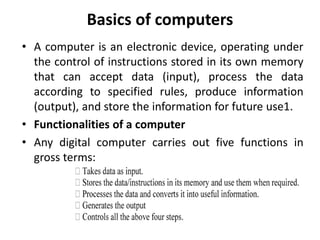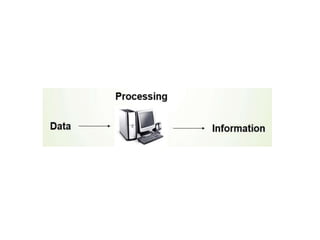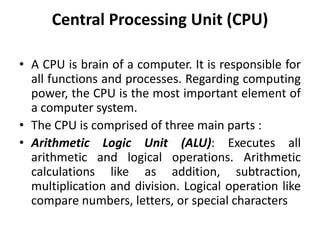Basics of computers.pptx
- 1. Basics of computers • A computer is an electronic device, operating under the control of instructions stored in its own memory that can accept data (input), process the data according to specified rules, produce information (output), and store the information for future use1. • Functionalities of a computer • Any digital computer carries out five functions in gross terms:
- 3. Computer Components • Any kind of computers consists of HARDWARE AND SOFTWARE. • Hardware: • Computer hardware is the collection of physical elements that constitutes a computer system. Computer hardware refers to the physical parts or components of a computer such as the monitor, mouse, keyboard, computer data storage, hard drive disk (HDD), system unit (graphic cards, sound cards, memory, motherboard and chips), etc. all of which are physical objects that can be touched.3
- 4. Input Devices • Input device is any peripheral (piece of computer hardware equipment to provide data and control signals to an information processing system such as a computer or other information appliance.
- 5. Cont…. • Input device Translate data from form that humans understand to one that the computer can work with. Most common are keyboard and mouse
- 7. 1. Keyboard 2. Mouse (pointing device) 3. Microphone 4. Touch screen 5. Scanner 6. Webcam 7. Touchpads 8. MIDI keyboard 9. 10.Graphics Tablets 11.Cameras 12.Pen Input 13.Video Capture Hardware 14.Microphone 15.Trackballs 16.Barcode reader 17.Digital camera 18.Joystick 19.Gamepad 20.Electronic Whiteboard 21.
- 8. Central Processing Unit (CPU) • A CPU is brain of a computer. It is responsible for all functions and processes. Regarding computing power, the CPU is the most important element of a computer system. • The CPU is comprised of three main parts : • Arithmetic Logic Unit (ALU): Executes all arithmetic and logical operations. Arithmetic calculations like as addition, subtraction, multiplication and division. Logical operation like compare numbers, letters, or special characters
- 9. Cont…. • Control Unit (CU): controls and co-ordinates computer components. – Read the code for the next instruction to be executed. – Increment the program counter so it points to the next instruction. – Read whatever data the instruction requires from cells in memory. – Provide the necessary data to an ALU or register. – If the instruction requires an ALU or specialized hardware to complete, instruct the hardware to perform the requested operation. • * Registers :Stores the data that is to be executed next, "very fast storage area".
- 10. Primary Memory:- • RAM: Random Access Memory (RAM) is a memory scheme within the computer system responsible for storing data on a temporary basis, so that it can be promptly accessed by the processor as and when needed. It is volatile in nature, which means that data will be erased once supply to the storage device is turned off. RAM stores data randomly and the processor accesses these data randomly from the RAM storage. RAM is considered "random access" because you can access any memory cell directly if you know the row and column that intersect at that cell.
- 11. Cont…. • ROM (Read Only Memory): ROM is a permanent form of storage. ROM stays active regardless of whether power supply to it is turned on or off. ROM devices do not allow data stored on them to be modified.
- 12. Secondary Memory:- • Stores data and programs permanently :its retained after the power is turned off • Hard drive (HD): A hard disk is part of a unit, often called a "disk drive," "hard drive," or "hard disk drive," that store and provides relatively quick access to large amounts of data on an electromagnetically charged surface or set of surfaces.
- 13. • Optical Disk: an optical disc drive (ODD) is a disk drive that uses laser light as part of the process of reading or writing data to or from optical discs. Some drives can only read from discs, but recent drives are commonly both readers and recorders, also called burners or writers.
- 14. Cont…. • Compact discs, DVDs, and Blu-ray discs are common types of optical media which can be read and recorded by such drives. Optical drive is the generic name; drives are usually described as "CD" "DVD", or "Bluray", followed by "drive", "writer", etc. There are three main types of optical media: CD, DVD, and Blu-ray disc. CDs can store up to 700 megabytes (MB) of data and DVDs can store up to 8.4 GB of data. Blu-ray discs, which are the newest type of optical media, can store up to 50 GB of data. This storage capacity is a clear advantage over the floppy disk storage media (a magnetic media), which only has a capacity of 1.44 MB.
- 15. Cont…. • Flash Disk • A storage module made of flash memory chips. A Flash disks have no mechanical platters or access arms, but the term "disk" is used because the data are accessed as if they were on a hard drive. The disk storage structure is emulated.
- 17. Output devices • An output device is any piece of computer hardware equipment used to communicate the results of data processing carried out by an information processing system (such as a computer) which converts the electronically generated information into human- readable form.
- 19. Example on Output Devices 1. Monitor 2. LCD Projection Panels 3. Printers (all types) 4. Computer Output Microfilm (COM) 5. Plotters 6. Speaker(s) 7. Projector : Note Basic types of monitors are a.Cathode Ray Tube (CRT). B. Liquid Crystal Displays (LCD). c.light- emitting diode (LED). Printer types: 1-Laser Printer. 2-Ink Jet Printer. 3- Dot Matrix Printer
- 20. Software • Software is a generic term for organized collections of computer data and instructions, often broken into two major categories: system software that provides the basic non- task-specific functions of the computer, and application software which is used by users to accomplish specific tasks.
- 21. Cont…. • Software Types • System software is responsible for controlling, integrating, and managing the individual hardware components of a computer system so that other software and the users of the system see it as a functional unit without having to be concerned with the low-level details such as transferring data from memory to disk, or rendering text onto a display. Generally, system software consists of an operating system and some fundamental utilities such as disk formatters, file managers, display managers, text editors, user authentication (login) and management tools, and networking and device control software.
- 22. Cont…. • Application software is used to accomplish specific tasks other than just running the computer system. Application software may consist of a single program, such as an image viewer; a small collection of programs (often called a software package) that work closely together to accomplish a task, such as a spreadsheet or text processing system; a larger collection (often called a software suite) of related but independent programs and packages that have a common user interface or shared data format, such as Microsoft Office, which consists of closely integrated word processor, spreadsheet, database, etc.; or a software system, such as a database management system, which is a collection of fundamental programs that may provide some service to a variety of other independent applications.
- 23. Comparison Application Software and System Software System Software Application Software Computer software, or just software is a general term primarily used for digitally storeddata such as computer programs and other kinds of information read and written by computers. App comes under computer software though it has a wide scope now. Application software, also known as an application or an "app", is computer software designed to help the user to perform specific tasks. Example: 1) Microsoft Windows 2) Linux 3) Unix 4) Mac OSX 5) DOS 1) Opera (Web Browser) 2) Microsoft Word (Word Processing) 3) Microsoft Excel (Spreadsheet software) 4) MySQL (Database Software) 5) Microsoft PowerPoint (Presentation Software) 6) Adobe Photoshop (Graphics Software) Interaction : Generally, users do not interact with systemsoftware as it works in the background. Users always interact with application softwarewhile doing different activities. Dependenc y: System software can run independently of the application software. Application software cannot run without the presence of the system software.
- 24. Cont…. • Unit of Measurements • Storage measurements: The basic unit used in computer data storage is called a bit (binary digit). Computers use these little bits, which are composed of ones and zeros, to do things and talk to other computers. All your files, for instance, are kept in the computer as binary files and translated into words and pictures by the software (which is also ones and zeros). This two number system, is called a “binary number system” since it has only two numbers in it. The decimal number system in contrast has ten unique digits, zero through nine.
- 25. Computer Storage units Bit BIT 0 or 1 Kilobyte KB 1024 bytes Megabyte MB 1024 kilobytes Gigabyte GB 1024 megabytes Terabyte TB 1024 gigabytes
- 26. Cont…. • Speed measurement: The speed of Central Processing Unit (CPU) is measured by Hertz (Hz), Which represent a CPU cycle. The speed of CPU is known as Computer Speed.
- 27. CPU SPEED MEASURES 1 hertz or Hz 1 cycle per second 1 MHz 1 million cycles per second or 1000 Hz 1 GHz 1 billion cycles per second or 1000 MHz
- 28. Computers classification*** • Computers can be generally classified by size and power as follows, though there is Considerable overlap: • Personal computer: A small, single-user computer based on a microprocessor. In addition to the microprocessor, a personal computer has a keyboard for entering data, a monitor for displaying information, and a storage device for saving data. • workstation : A powerful, single-user computer. A workstation is like a personal computer, but it has a more powerful microprocessor and a higher-quality monitor.
- 29. Cont…. • minicomputer : A multi-user computer capable of supporting from 10 to hundreds of users simultaneously. • mainframe : A powerful multi-user computer capable of supporting many hundreds or thousands of users simultaneously. • supercomputer : An extremely fast computer that can perform hundreds of millions of instructions per second.
- 30. Laptop and Smartphone Computers • LAPTOP: A laptop is a battery or AC-powered personal computer that can be easily carried and used in a variety of locations. Many laptops are designed to have all of the functionality of a desktop computer, which means they can generally run the same software and open the same types of files. • However, some laptops, such as netbooks, sacrifice some functionality in order to be even more portable.
- 31. Cont…. • Netbook: A netbook is a type of laptop that is designed to be even more portable. Netbooks are often cheaper than laptops or desktops. • They are generally less powerful than other types of computers, but they provide enough power for email and internet access, which is where the name "netbook" comes from.
- 32. • Mobile Device: A mobile device is basically any handheld computer. It is designed to be extremely portable, often fitting in the palm of your hand or in your pocket. Some mobile devices are more powerful, and they allow you to do many of the same things you can do with a desktop or laptop computer. These include tablet computers, e-readers, and smartphones. •
- 33. Cont…. • Smartphones: A smartphone is a powerful mobile phone that is designed to run a variety of applications in addition to phone service. They are basically small tablet computers, and they can be used for web browsing, watching videos, reading e-books, playing games and more.
- 34. Data, Information and Knowledge • Data: Facts and figures which relay something specific, but which are not organized in any way and which provide no further information regarding patterns, context, etc. • So data means "unstructured facts and figures that have the least impact on the typical manager."
- 35. Cont…. • Information: For data to become information, it must be contextualized, categorized, calculated and condensed. • Information thus paints a bigger picture; it is data with relevance and purpose. • It may convey a trend in the environment, or perhaps indicate a pattern of sales for a given period of time. • Essentially information is found "in answers to questions that begin with such words as who, what, where, when, and how many".
- 36. Cont…. • Knowledge: Knowledge is closely linked to doing and implies know-how and understanding. • The knowledge possessed by each individual is a product of his experience, and encompasses the norms by which he evaluates new inputs from his surroundings.
- 37. Cont…. • The content of the human mind can be classified into four categories: • Data: symbols • Information: data that are processed to be useful; provides answers to "who", "what", "where", and "when" questions • Knowledge: application of data and information; answers "how" questions • Wisdom: evaluated understanding. • We need to understand that processing data produced Information and process Information produces Knowledge and so on
- 38. Characteristics of Computer • Speed, accuracy, diligence, storage capability and versatility are some of the key characteristics of a computer. A brief overview of these characteristics are
- 39. Cont…. • Speed: The computer can process data very fast, at the rate of millions of instructions per second. Some calculations that would have taken hours and days to complete otherwise, can be completed in a few seconds using the computer. For example, calculation and generation of salary slips of thousands of employees of an organization, weather forecasting that requires analysis of a large amount of data related to temperature, pressure and humidity of various places, etc.
- 40. Cont…. • Accuracy: Computer provides a high degree of accuracy. For example, the computer can accurately give the result of division of any two numbers up to 10 decimal places. • Diligence: When used for a longer period of time, the computer does not get tired or fatigued. It can perform long and complex calculations with the same speed and accuracy from the start till the end
- 41. Cont…. • Storage Capability: Large volumes of data and information can be stored in the computer and also retrieved whenever required. • A limited amount of data can be stored, temporarily, in the primary memory. Secondary storage devices like floppy disk and compact disk can store a large amount of data permanently.
- 42. Cont…. • Versatility: Computer is versatile in nature. It can perform different types of tasks with the same ease. • At one moment you can use the computer to prepare a letter document and in the next moment you may play music or print a document. • Computers have several limitations too. Computer can only perform tasks that it has been programmed to do.
- 43. Cont…. • Computer cannot do any work without instructions from the user. • It executes instructions as specified by the user and does not take its own decisions.
- 44. Computer Viruses* • Viruses: A virus is a small piece of software that piggybacks on real programs. • For example, a virus might attach itself to a program such as a spreadsheet program. • Each time the spreadsheet program runs, the virus runs, too, and it has the chance to reproduce (by attaching to other programs) or wreak havoc.
- 45. Cont…. • E-mail viruses: An e-mail virus travels as an attachment to e-mail messages, and usually replicates itself by automatically mailing itself to dozens of people in the victim's e-mail address book. • Some e-mail viruses don't even require a double-click -- they launch when you view the infected message in the preview pane of your e-mail software [source: Johnson].
- 46. Cont…. • Trojan horses: A Trojan horse is simply a computer program. The program claims to do one thing (it may claim to be a game) but instead does damage when you run it (it may erase your hard disk). Trojan horses have no way to replicate automatically. • •Worms: A worm is a small piece of software that uses computer networks and security holes to replicate itself. A copy of the worm scans the network for another machine that has a specific security hole. It copies itself to the new machine using the security hole, and then starts replicating from there, as well.












































![Cont….
• E-mail viruses: An e-mail virus travels as an
attachment to e-mail messages, and usually
replicates itself by automatically mailing itself
to dozens of people in the victim's e-mail
address book.
• Some e-mail viruses don't even require a
double-click -- they launch when you view the
infected message in the preview pane of your
e-mail software [source: Johnson].](https://image.slidesharecdn.com/basicsofcomputers-221112123035-ec223840/85/Basics-of-computers-pptx-45-320.jpg)



